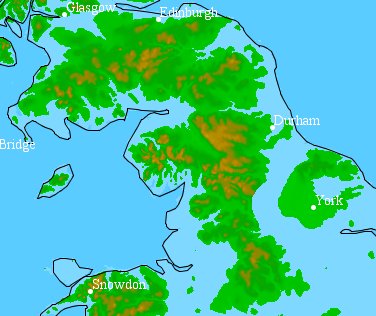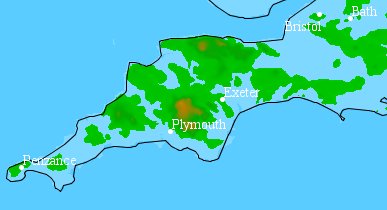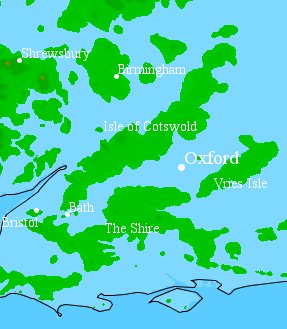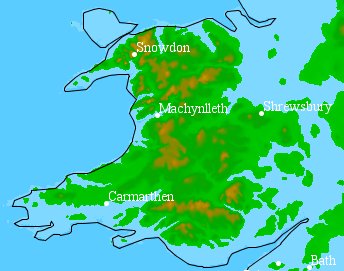The Archipelago of Albion
Overview
Reshaped by flood and magic, war and industry, the scattered islands of Albion bear little resemblance to historical 17th Century England in shape. Though a great deal of information is included below this is largely for reference and flavour – the map above and section on the Flood below are all that you really need to read.
The Flood
The rains began in 1607. Some say shortly before the Regicide; some after - so many records from that terrible, treacherous time have been lost that it is impossible to say when.
Although there were moments of calm in the storm, in real terms, they did not stop until 1616. The Flood was truly Biblical, and as the waters rose and rivers burst their banks, voices across the land began to cry out that the Apocalypse had come to Albion; that the Catholic scourge, or Protestant treachery, or the Jews, or the impious Puritans, or the Irish or the Philosophers were to blame. Whether Magical or natural, Divine or Diabolical, the Flood sent Europe - and, to a lesser extent, countries further off - into turmoil and disaster.
Cities with particularly well-regarded Magicians were the first to be protected from the floodwaters, in one method or another; residents of those unlucky cities and states without such magical protections fled, or drowned.
OC Note: Albion is not a game which tries to simulate the real world, and thus the effects of the Great Flood should not be considered in a scientific fashion. Much of the landscape has been changed by Magical effect or apparently Divine intervention; the effects upon geography are not in line with current predictions on (for example) Global Warming, but are rather metaphysically distinct to the setting. In short: This is not a hard-science game. Geography is a science.
Scotland
Scotland is as much a part of the Kingdom as any other part of the Archipelago, with only a few pockets of resistance to King Matthew's rule. However, as a once-great nation in its own right, it has its political complexities; thus it has a separate page of its own at Scotland.
Northern Albion
The Pennine Strip
The Pennine Strip is an area of land naturally unsuited to agriculture and yet largely devoted to it. The mountains from which it takes its name, the Scots tribes north of the Channel, and the distance from Oxford have discouraged many of the rich from building their country estates here. So, in a land where space is at a premium it has become the stronghold of the peasants, the farmers and the Border Lords.
The Border Lords is the highly inaccurate term in common usage for those nobles whose land lies on the Pennine Strip. Their reputation as hardy individualists, taming the mountains and Scots alike, would be far more believable if it were not for the coffee houses and fine tailors that fill Edinburgh. In truth, most of the land is peaceful, with the worst privation a young Lord may face being finding a fair day to hunt on. As you push north towards the Channel, the Lords often become Lairds, as the Scots who did not cross the Channel continue business as usual, ignoring the English and making deals with their Highland cousins to keep raids to a manageable level. To the English they are Scots who have seen the light. To the Scots they are keeping the land safe until it can be reclaimed, making unfortunate but necessary concessions (such abandoning Puritan religious teaching to attend Church of England Mass). Or traitors to be hanged at the first opportunity. Opinions vary.
Edinburgh is the island's largest city, highly Anglicised and fortified. Competition with York to be the region's main port is fierce, though futile as York's concentration of magicians gives it a great advantage. Despite attempts to increase the standing of its University (founded 1583), many were wary of the city's Puritan leaning and an Institution untested by the centuries. Though filled by the children of those realising the value of an Education in an increasingly academic country, Edinburgh degrees are widely looked down on.
Cultivation of the Strip is intense, and relies heavily on assistance from the Sisters of Hecate. With the assistance of spirits resident in the lands, they have coaxed grass to grow thicker and stronger for the sheep that roam over the tops of the hills. Plants grow wherever they can, hardy ones carefully worked into something edible, and those less so coaxed to grow where they might not. Blight, insects and vermin have been persuaded to develop a taste for those plants which humans find harder to stomach. This is not to say that food is plentiful, merely that there is far more than there would be without the Sisters' work.
It may not be surprising, therefore, that the relations between the Sisters and nobles of the north are very good, as those nobles who slight a witch can expect their own crops to become scarce. Though no nobles would admit to being forced out by the Sisters, there are a number currently residing in their Edinburgh town houses whilst a relative or underling runs their estates.
The Bay of York
Rrrh'n heih hw'haé ae-sta mnenhi'thae.
Dragon-fire reshapes the land just as well as water.
– Lugh, one of the first dragons to come to England, on the moving of a section of the Pennines to protect York from rising waters
Formed by the removal of a large chunk of the Pennines by a force of dragons, the Bay of York consists of the city of York itself, surrounded and protected from the sea by walls of rock, and then two flatter strips of land circling around the bay.
York itself has grown up to fill the pocket in which it sits, and it is now a mark of standing in the city to own a house carved into the rock. Not only are these naturally a pleasant temperature the year round, they also give a pleasing view down onto the city. Wide terraces have been carved into the rock, enabling travel within each tier. From tier to tier carriages suspended on sturdy ropes are hauled up and down by demons, so that nobles (or goods) may travel in comfort, though there are also winding stairs in case of malfunction. A number of the younger nobles have taken to keeping gryphons in the place of horses, and this has lead to the custom for both men and women of quality to carry parasols on strolls through the city, to lessen the impact of any accidents.
The town is home to many magicians, who had taken haven their in less fortunate times and never left. It lacks the prestige of Oxford, but for the prudent there is a great benefit to living in the city, or even on one of the outer strips. Magical innovation here is rather more domestic in nature than at the Colleges, and so it is often here that new advances are made, to be moved to Oxford in a matter of months when an investor is found.
The poorer inhabit the strips of land to either side of the town, where most of the food for the region is grown. The variety of magicians within the city itself leads to an equally varied range of improvements to the foods. Thus it is that mile-high beanstalks rub shoulders with herds of sheep attended by a rather put-upon looking demon with a whip in one hand and a feeding trough in the other.
It is on the uppermost of these strips that the Horticulturalists have their northern base, on Ilkley Moor. This is home to the largest known breeding group of gryphons in Albion, currently estimated to be 342. One of the more enthusiastic recipients of the magicians' latest products, they are less popular in the town itself, where a visiting Hortie can expect comments on the smell (his and the gryphons'), dress and mannerisms, and few of them favourable.
The bay itself has a heavily fortified entrance, and so has filled up with floating homes and bazaars alike. Many have no way to move without assistance, and so a fleet of tug-boats can usually be seen darting through the bay, each small group offering to pull merchants into a choicer spot, or praising the view that can be had from the other side of the bay, which you could be enjoying from your boat in a matter of hours, for a small fee of course.
South-East England
The south-east of England was the area hardest hit of all by the Flood. Norfolk is entirely gone, and most of the south-east coast has been reclaimed by the sea. The City of London is underwater, abandoned ahead of the rising flood waters after the first Civil War devastated what was once the jewel in Albion's crown. What is left of life in this part of England is still reeling from the shock.
General outlook
The residents of this area of Albion are in general a backward-looking people, reminiscing over past glories and the loss of their place in the world. The lack of land means that the South-East is pretty much ignored by the rest of the country. With very little to offer, what else do they have to live for?
Places
The port of Dover was lucky to be partially built at the top of the cliffs. This meant that the town was not entirely lost as the floodwaters rose; indeed, many forward-looking businessmen moved much of their business upwards, leaving the docklands themselves to flood. Once the sea level stopped rising, a new port was built. However, Dover is not the town it once was. With little to offer the rest of the country, few ships from abroad dock here now. Much of the newly-built dockland has been left to fall into disrepair when it became obvious they would never be used.
Brighton, on the other hand, is a small fishing town that has grown into a small island-city in recent times. Its position in the middle of a small chain of other islands has made it the centre of this part of the south-east - the residents tend to be more forward-looking than the majority of people in this corner of the country, giving hope that one day the past can be put firmly into the past.
However, the residents of Invictus tend to strongly disagree. Invictus is the island directly to the south of where London used to stand. As a people they believe that London will be reborn from the fire and flood, to take its place once more as the Capital of Albion. They live for an idealised view of what London used to be; fashion, face and position are very important, poets and fops are feted and followed by the masses. And in Epsom College, Scientists of all stripes get together in the common room and discuss ways to raise London from the sea.
The one great exception to the mood of the south-east is the Isle of Welwyn, situated due east of Vries Isle. The island is becoming very built up as the islanders ape the socialites and businessmen who live so close. However, most residents of Vries Isle look down on Welwyn, seeing them as a load of upstart commoners (but still pretty funny to look at).
South-West England
Cornwall
Cornwall suffered quite badly in the Flood, with much of its land now beneath the water. However, the four islands of Penzance, Falmouth Austell and Bodmin (the largest) still consider Cornwall to be one county, their fraternal bonds even stronger than before the Flood. The town of Penzance, destroyed by the flood, has been rebuilt on the island of the same name and is now home to the Venerable Order. The people of Cornwall support the Order, and have many new recruits have come from the county.
However, there is a darker undercurrent to the close bonds shared by the Cornishmen. As a people they have harboured the belief for centuries that Cornwall should be independent of Albion. After the Flood, and with no land link to the capital any more, talk of seccession has increased and can be heard in many taverns, particularly on Penzance and Falmouth.
Devon
Devon was less affected by the flooding than the rest of the south-east. Exeter and Plymouth are now thriving ports, having been rebuilt further inland when the sea took them both. Devon is still mostly rural, but both Exeter and Plymouth are large urban districts, with many magicians of all stripes. People in Plymouth tend to be less self-concious and take themselves less seriously than those nearer the Capital, whilst those of Exeter are often found aping the latest fashions of the Oxford courtiers.
Dorset
Much of Dorset is sunk beneath the waves. The county has ended up split into two, with part subsumed into The Shire and the rest tacked onto Devon. True Dorset folk look with disfavour on those who have become part of the Shire, close to Oxford. Most work in fishing (for the poorer folk) or agriculture (for those who have the land). They are sullen but hardy folk, and have little time for those who can't pull their weight.
Somerset
Like Dorset, Somerset has lost a large chunk from its very heart. However, the estates of the Duke of Somerset and his family were left mostly untouched but the flood. The land to the south-west of the country shares a border with Devon, and the two counties get along extraordinarily well. New towns have sprung up throughout Somerset, but much of the land is still devoted to agriculture.
The Isle of Lundy, sunk beneath the waves, used to be found to the north-west of Somerset. The waters around these lands are avoided by all but the most foolhardy sailors. The sea roils and churns for miles around the area, and some men speak of dark and fearsome beasts found frolicking in the hell-touched waters.
South-Central England
The heart of society in Albion, south-central England is home to the King's capital at Oxford and the estates of the rich and powerful. The ferry-routes between islands here are plentiful, well-guarded (and expensive!); the land-masses crowded, with everyone who is anyone vying for a tiny estate - or at least a modest town-house - somewhere in the Inner Isles.
Most of what is important in South-Central England can be found at the Oxford and Oxford Society pages, but it is important to have a sense of one's neighbours. These three large islands - the Isle of Cotswold, the Shire, and Vries Isle - are the most central islands, both socially and administratively, to the Archipelago; they are home both to the townhouses of middling and minor gentry, to those who serve the richest and most powerful individuals on Oxford, clean their houses, bake their bread and repair their boats.
Isle of Cotswold
This island could be considered the machinery behind Oxford. Ugly and efficient, it supplies the servants, food and increasing number of magical items which are considered necessary for civilized life.
Walls strengthened with dragon-forged steel, towers soon shot up to house the workers required in Oxford and the other Isles. Similar improvements were made in horticulture, with racks of soil and plants stacked upon each other, and lit by Alchemical fire. This was until the Flash-Fire of 1627, which taught all inventors why mixing wooden supports and explosive lights was a bad idea, clearing large expanses of the island for further high-rise buildings, though this time with stone walls.
The Shire
It is almost as if country life before the flood had been frozen and trapped on this island. Those still too attached to their horses to trade them in for boats can ride them and, though there is very little unused land, some effort has been made to ensure that the agriculture is pleasing to the eye. If, perhaps, it is through orchards rather than forests you gallop, it is little issue.
It is here where the memorials for those who died in the Civil Wars were erected, in lieu of grave stones. A park houses them all, in a rare piece of common land that exists for no other purpose than enjoyment, and remembrance.
Vries Isle
After a strenuous day being seen in Oxford, this is where a noble might come home to relax, perhaps visiting a coffee house to talk business with a few friends, a house of entertainment where companions await to soothe away the cares of the day, or even just going home to sleep.
The rabble of financial institutes who cannot afford a presence in Oxford find their homes here, and even Roebury’s and MISC, the two who can, have their largest offices here. The Inns of Court, too, have found a new home – relocated from London, rumour goes, with some of the young gentlemen inside never noticing the difference.
Notable amongst the pleasure houses is Moly’s, a towering building of 21 stories which contains an inn, brothel and gaming house so that a lady, or gentleman, may engage in a variety of entertainments without ever having to brave the cold air outside. The rooms inside are lit, night and day, with a warm glow so that no unnecessary reminder of the hour might disturb the mind.
Innovations in fitting lavish houses into small spaces have increased rather rapidly in popularity in recent years – many of the town houses here have interiors which certainly aren’t contained entirely within the walls. It is rare to find a titled and monied noble on Vries Isle who does not have some Magician or other, however amateurish, hanging off him for patronage and favour.
Wales
Wales suffered much less than any other part of Albion, except maybe Scotland. The Island of Wales encompases all the land above sea-level in the old Wales and the rest of the land connected to it, and the border of Wales has expanded to include Shropshire, Herefordshire and parts of Worcestershire and Gloucestershire. Much of this land is devoted to agriculture.
As the largest landmass in the south of Albion, Wales has a high and healthy population. After the Flood, moved in to take advantage of the huge amounts of land toward the central parts of Wales. In general the Welsh have accepted this with good grace, particularly given the increase in importance of Wales since the flood. However, there are a significant number who object to the influx of English. In particular, the more mountainous areas and the mid- and north-west of the island are gaining a noticeable anti-English sentiment.
Cities
Shrewsbury has grown considerably in recent years, and is now a small city. The city is particularly famous for its clothing export; the sheep of Wales give particularly fine wool, very popular in Oxford society, and the majority of it moves through Shrewsbury. The woolen quarter is full of spinners, weavers, dyers and tailors.
Machynlleth is a port city on the west coast of Wales. With a majority of Welshmen and many of the residents native Welsh speakers, Englishmen can find it difficult to make inroads into the business of the city. The ancient Capital of Wales in the day of Owain Glyndywr, it is now a centre for Welsh nationalist sentiment on the island.
Carmarthen has also grown into a large port town. Situated on the south coast of the island, it has a large fishing industry.
Other places of note
Mount Snowdon is home to the King's Own Horticulturalists. They have taken control of the area around the mountain to house and train their Dragon-riding troops. Unfortunately the dragonfire has denuded the surrounding area of trees, grass and sheep.
Cadair Idris is the second-highest mountain in Wales, and home to the extraordinarily rare Careg Rose. Unfortunately it is protected by the Order of Blodeuwedd. Little is known of the Order, except that they live on the Mountain and keep travellers and seekers after the Flower from taking it from the mountain.






